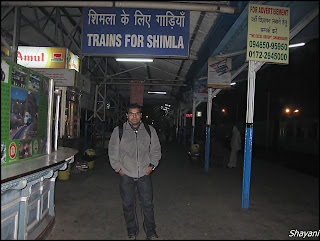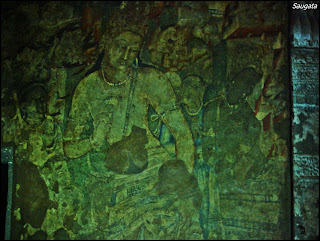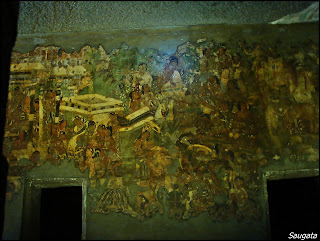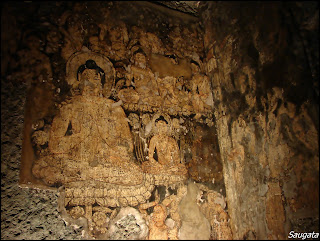Cave 1
This is one of the important caves which contains a lot of paintings. There is a large hall and pillars around both sides. Many important and famous paintings and sculptures are here as below – the great Buddha Image, Goddess, Cherubic Dwarf, bodhisattva, four deers with a common head, the lovers, dark princess, dancing girl, princess reclining by a pillar, a maid in a sad mood, Persian embassy, the golden geese, pink elephant, bull fight etc. The most famous painting here is ‘Boddhisattva Padmapani (Lotus in hand) and Vajrapani’ which are considered to be one of finest paintings in the world of art.
Cave 2
This is next to Cave 2 and another important cave. This is quite similar to cave in architecture and also contains many fabulous paintings on the walls and the ceilings. The skill with which painters lay down on scaffoldings for long years, to paint these pictures, is reminiscent of the way Michelangelo suffered physical strain while painting the ceilings of the Sistine Chapel in the Vatican in Rome. The famous paintings here are – Thousand Buddhas, Votaries with Offerings, Women on Swing.
Cave 3
This is an incomplete vihara (monastery) and there is nothing of much significance.
Cave 4
This is also a vihara which consists of a hall and pillared verandah. This is the largest monastery of the Ajanta excavations. The cave was also painted which is visible from the remnants.
Cave 5
This is an unfinished Vihara.
Cave 6
This was the first important cave of the Mahayana phase. This is a double storeyed monastery. It also has some fabulous paintings such as – Bhikshu with Lotus, Miracle of Sravasti, Temptation of Mara the Evil One.
Cave 7
This is another monastery which contains sculptural marvels like – preaching Buddha, Miracle of Sravasti, seated Buddha under the protection of Nagamuchalinda, etc
Cave 8
This is an unfinished monastery located at the lowest level and perhaps earliest among the monasteries. Major portion of the frontage has been swept away by a landslide.
Cave 9
This is a Chaitya (prayer hall). There are two early paintings, which survive. Frieze of Animals and Herdsmen Naga Worshippers. The chaityagriha exhibits reproduction of wooden architectural styles
Cave 10
This is another Chaitya Hall. This also houses some famous paintings – King with His Retinue, Shad-danta Jataka, Shyama Jataka, Elephants in Jungle, Pricess and Tusk, Buddha and the One-eyed Monk, etc.
Cave 11
This is another monastery which has an unfinished stupa. Few paintings that available here depicts Bodhisattvas, figures of Buddha, etc. This cave is also interesting as it shows the transition from Hinayana to Mahayana.
Cave 12
This is a monastery and front wall of which is completely collapsed.
Cave 13
This is a small monastery.
Cave 14
This unfinished monastery was excavated above Cave 13 at a higher level.
Cave 15
This is a monastery with eight cells, antechamber and pillared verandah. The sculptural depictions include Buddha in various postures, seated Buddha etc. The traces of paintings indicate that it was originally painted.
Cave 16
One of the finest paintings of the art world is housed here – the Dying Princess. The other notable paintings here are Buddha with a Begging Bowl, Prince Siddharth stretching the bow, the Sutasama Jataka etc. There is a giant statue of Buddha in a teching gesture.
Cave 17
This monastery is another example of the finest paintings – Apsaras and the flying spirits, Indra and the Apsaras, Royal Procession, Shad-danta Jataka, Prince Simhala, The Buddha Returns.
Cave 18
This consists of a rectangular excavation leading into another cell. This houses one of the exquisite paintings – Princess looking in the mirror.
Cave 19
This is a Chaitya hall. The stupa is carved with a standing image of Buddha.
Cave 20
This is a pillarless monastery. Buddha in preaching attitude is housed in the sanctum. The sculpture of seven Buddhas accompanied by attendants is another important sculptural panel in this cave.
Cave 21
One of the most fabulous of Ajanta, from the perspective of the carvings. This is basically a chaitya hall which houses a 24 ft long statue of dead Buddha on the left wall – This is called as ‘Buddha in Parinirvana’. There are carvings of disciples of Buddha moaning and heavenly deities welcoming Buddha in heaven. The peacefulness which was carved on Buddha’s face is truly astonishing. As per my opinion, this is the best of Ajanta’s sculptures, at least if expressions are concerned.
Cave 22
The sculptural depiction of Buddha in different forms, painted figures of Manushi-Buddhas with Maitreya can be noticed here. This is basically a monastery.
Cave 23
This is an unfinished monastery.
Cave 24
This is another incomplete monastery.
Cave 25
This is a monastery but the hall is devoid of any shrine.
Cave 26
This is similar chaityagriha like cave 19, but much bigger than 19. The horseshoe arch is quite breathtaking. There are various sculptures, undoubtedly carved with rare talent and skill.
Cave 27
The monastery consists of a hall with four cells, antechamber and sanctum sanctorum. Buddha in teaching attitude is housed inside the sanctum.
Cave 28
This is an unfinished monastery.
Cave 29
This is an unfinished chaitya griha.
Under the scorching heat, we were quite exhausted by now. We did take a lot of rest in between traversing through the hills. We required a lot of water intake without which it is impossible to walk. We now started towards the exit. We crossed a small bridge on the river Waghora. The path through jungle was quite pleasant with cool shadows provided by the trees. A lot of fully bloomed flowers were there to enjoy, if one can after the industrious walk. We came to outer entrance and went into the MTDC restaurant just to find out that the place is fully occupied. We were quite hungry but other than this place, there were not eateries around. Upset, we came back to queue for the bus. Buying the tickets, we came to the base and hurried to the first eatery we found and had a sumptuous meal. It was already 5 pm, but we could see hoards of people still proceeding towards the top. I came to know from a local that these are the people who would stay at the MTDC resort and would start their journey in the early morning. It seemed a great idea to me. If there is a next time, I will definitely do this.
We came back to the hotel around 7.45 pm, had a bath and then an early dinner and went to bed straightaway after the hectic but deserved effort.
Ajanta made us both exuberant and poignant. We – and thousands others, Indians, Japanese, Koreans, English, Americans, French – all were spellbound, hypnotized and mesmerized. The paintings had so much expression and emotions, the sculptures were so much precise to the minutest of detail that we were completely swept away by their splendid grandeur.
We have now with us an experience of a lifetime.
Paintings -
Carvings -
Sources:
For this post, I acknowledge -
http://en.wikipedia.org/wiki/Ajanta_Caves
http://www.aurangabaad.com/
http://ajantacaves.com/
http://asi.nic.in/
























































